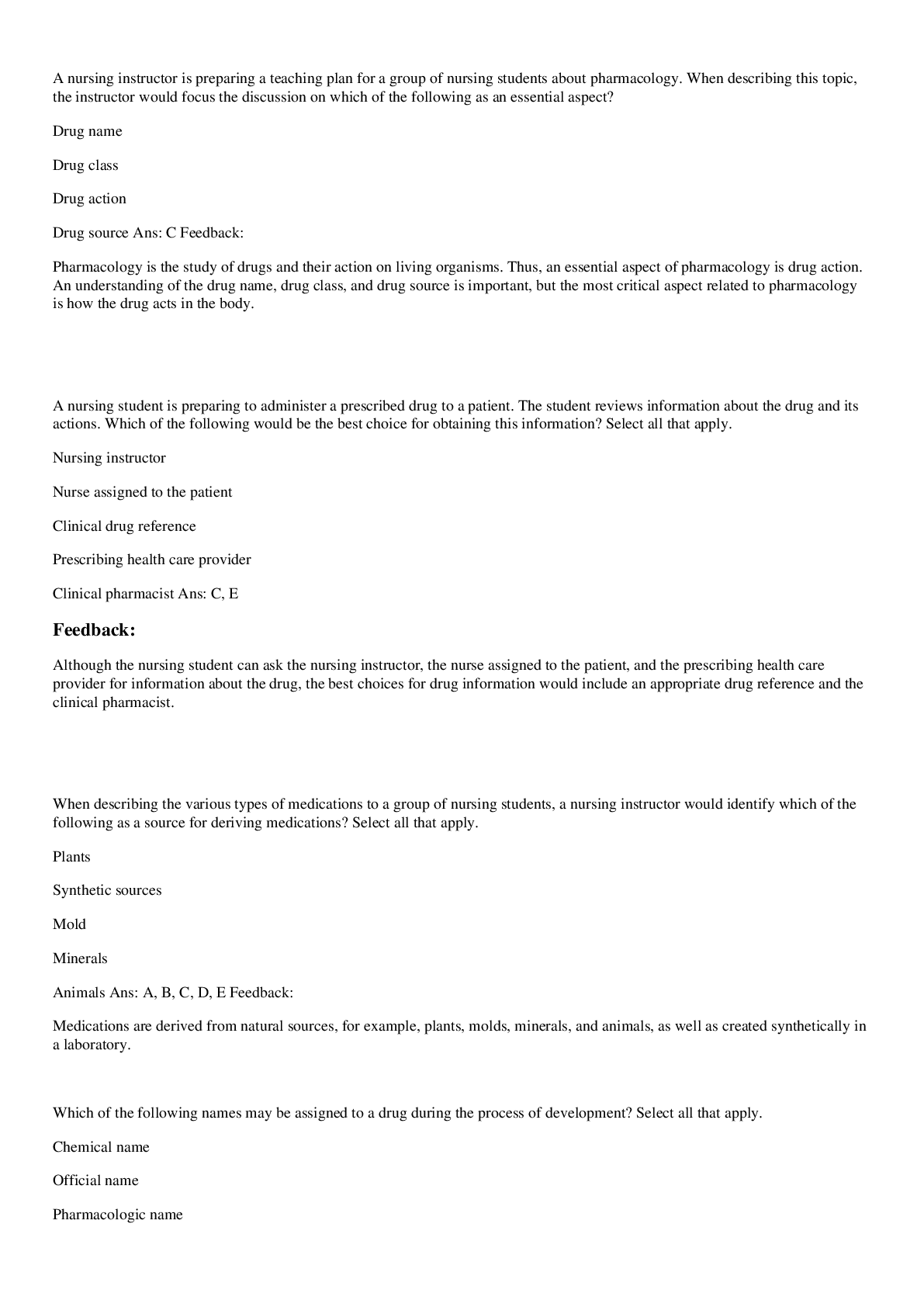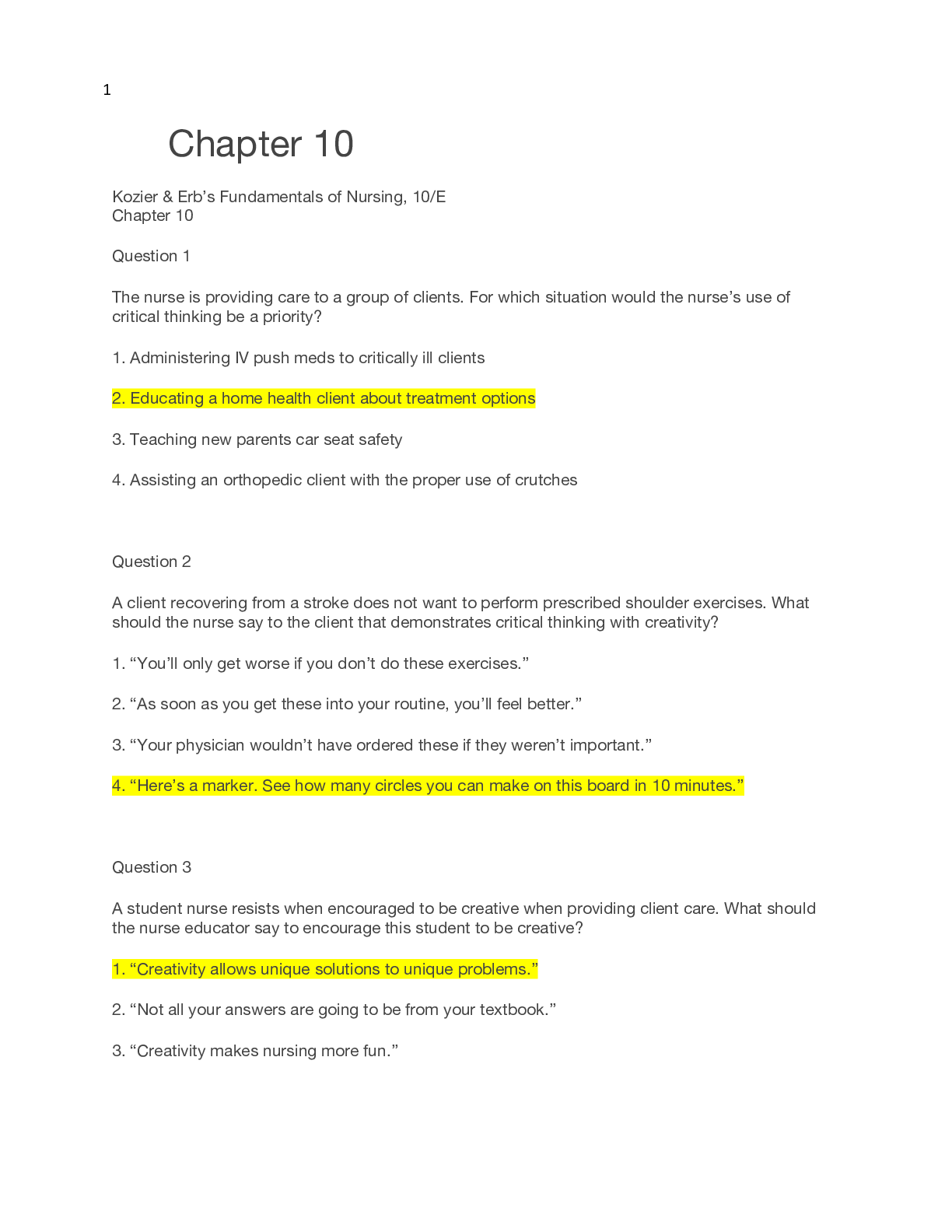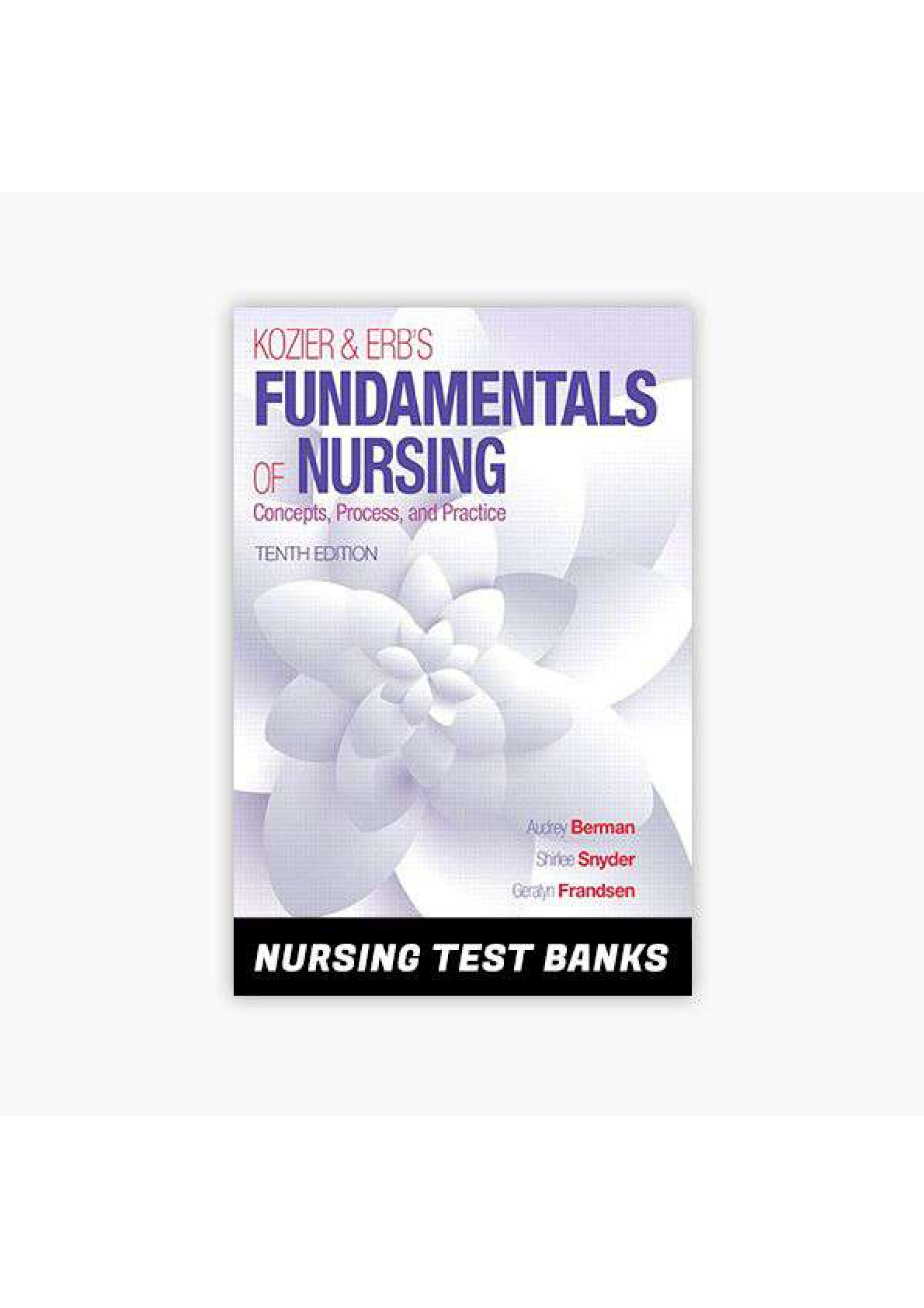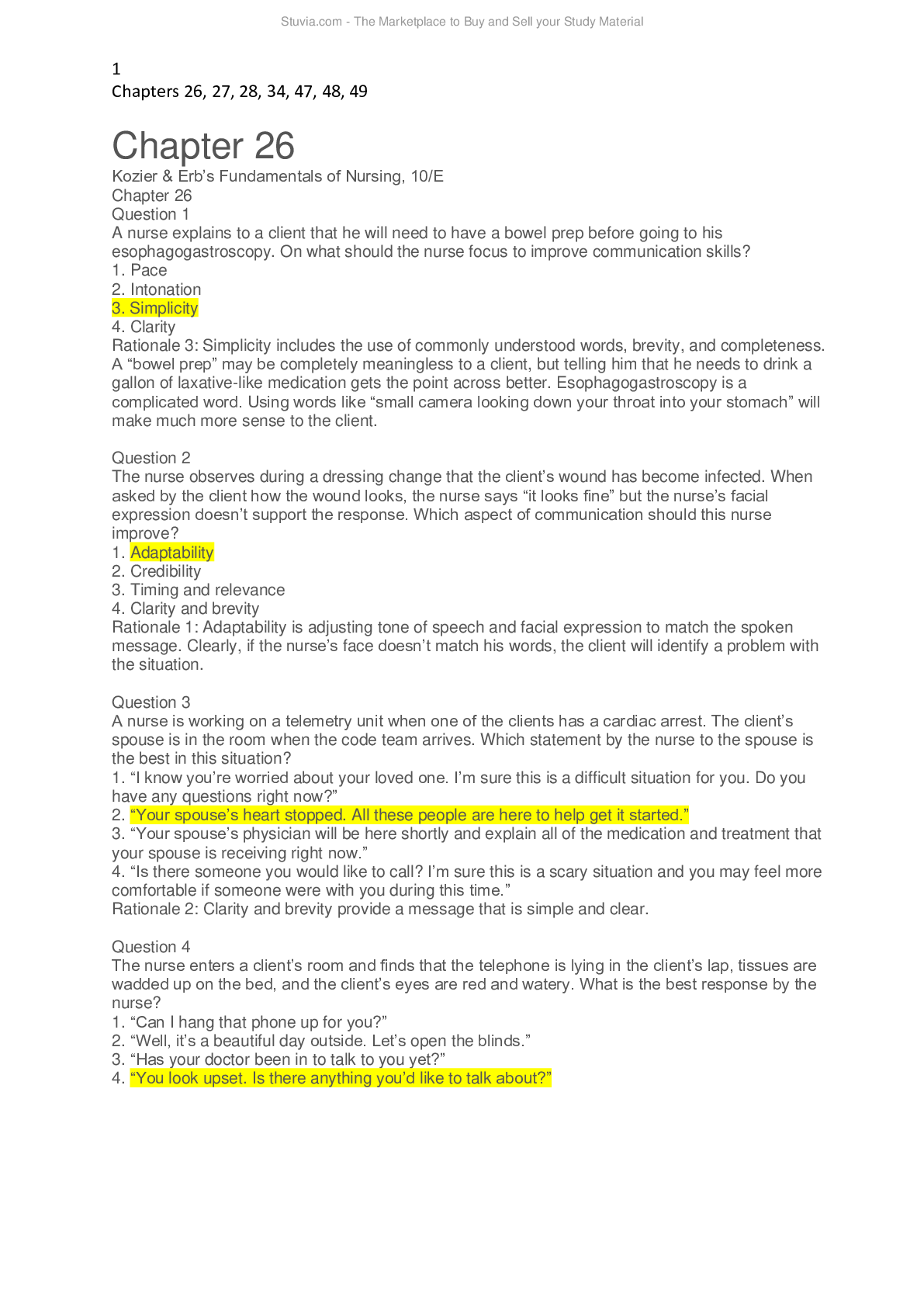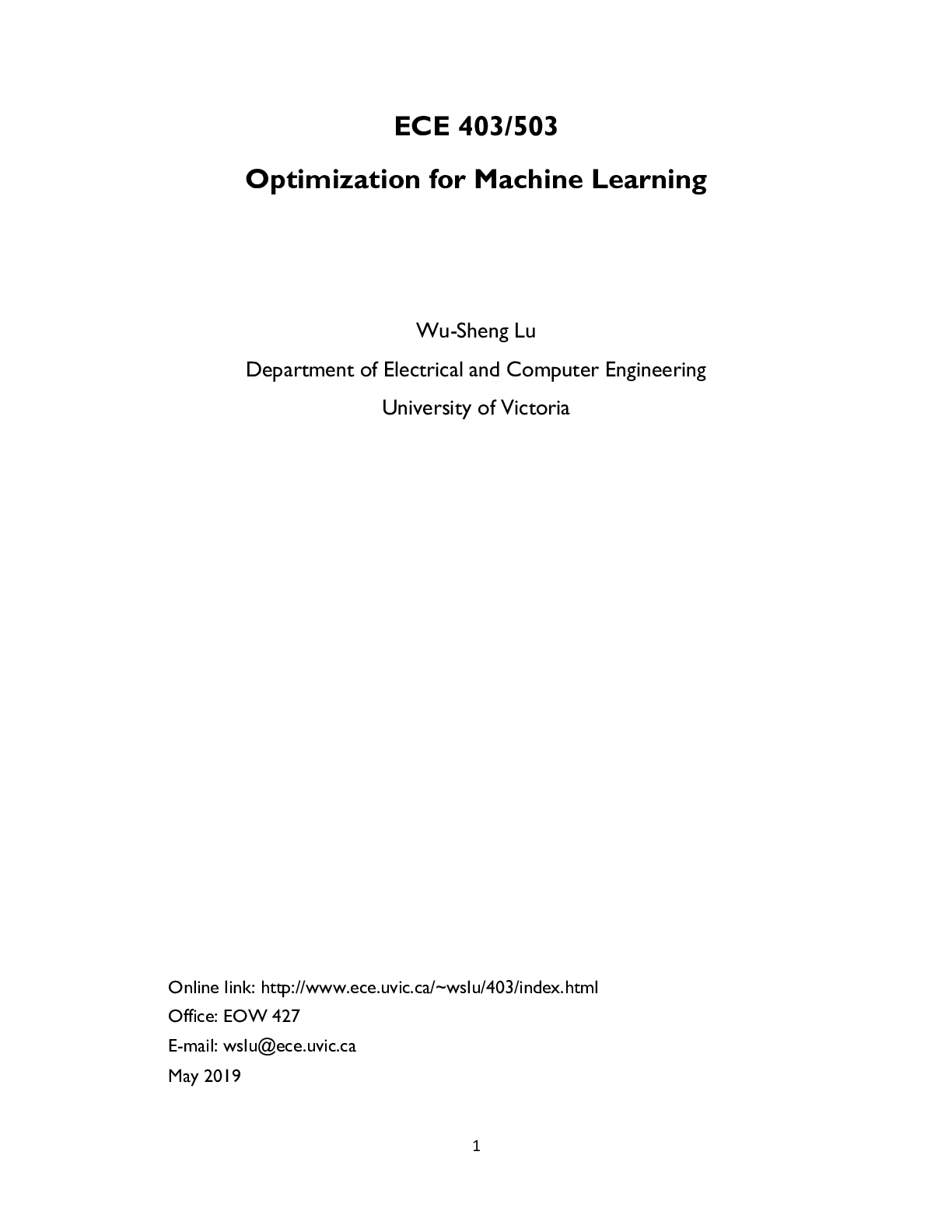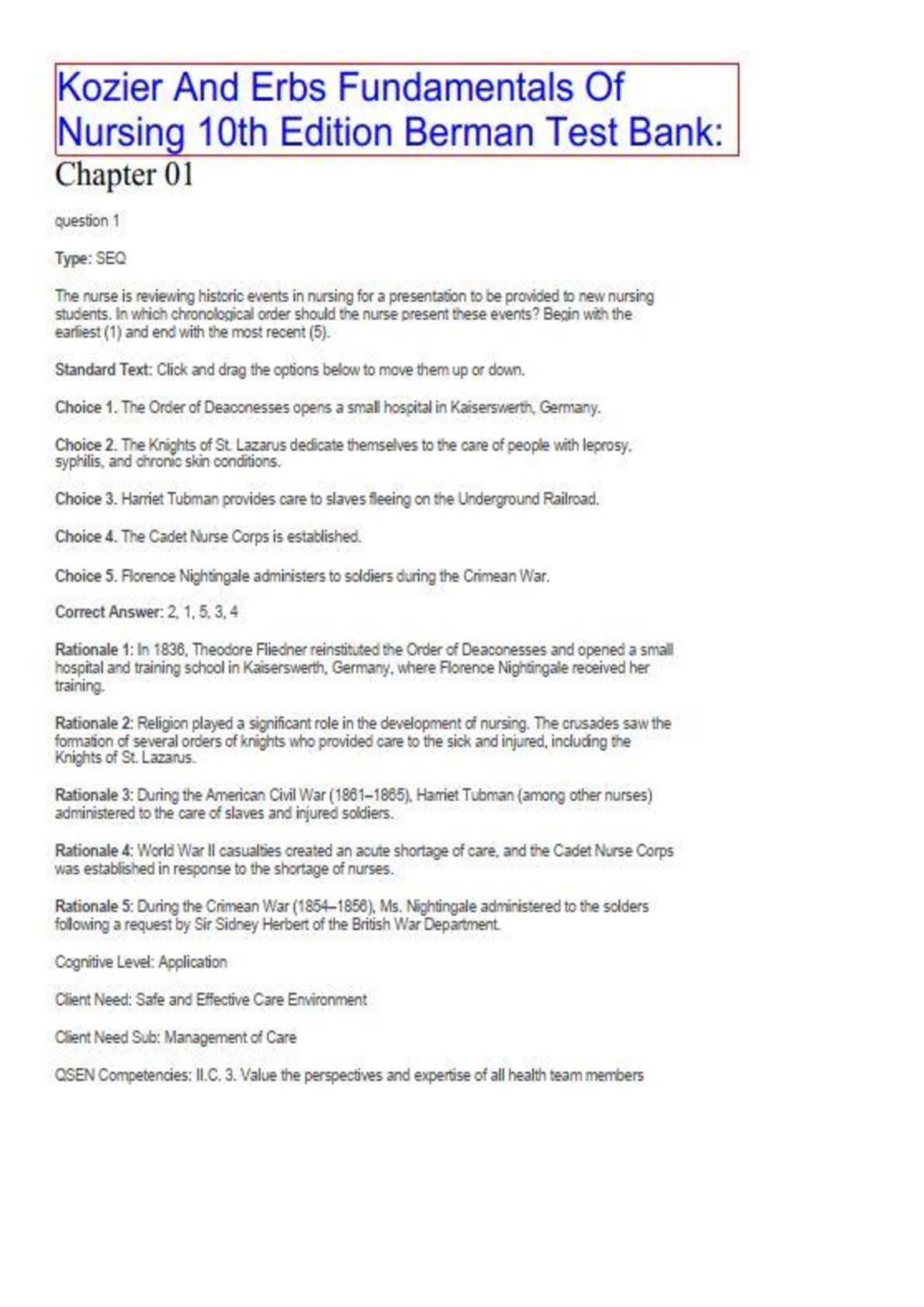*NURSING > TEST BANK > Kozier and Erbs Fundamentals of Nursing – 10th Edition Test Bank; Chapters 26, 27, 28, 34, 47, 48, (All)
Kozier and Erbs Fundamentals of Nursing – 10th Edition Test Bank; Chapters 26, 27, 28, 34, 47, 48, 49_Exam 3 Study Guide.
Document Content and Description Below
Kozier and Erbs Fundamentals of Nursing – 10th Edition Test Bank; Chapters 26, 27, 28, 34, 47, 48, 49_Exam 3 Study Guide. Answered fully_Latest 2020 Chapter 26 Kozier & Erb’s Fundamentals of Nur... sing, 10/E Chapter 26 Question 1 A nurse explains to a client that he will need to have a bowel prep before going to his esophagogastroscopy. On what should the nurse focus to improve communication skills? 1. Pace 2. Intonation 3. Simplicity 4. Clarity Rationale 3: Simplicity includes the use of commonly understood words, brevity, and completeness. A “bowel prep” may be completely meaningless to a client, but telling him that he needs to drink a gallon of laxative-like medication gets the point across better. Esophagogastroscopy is a complicated word. Using words like “small camera looking down your throat into your stomach” will make much more sense to the client. Question 2 The nurse observes during a dressing change that the client’s wound has become infected. When asked by the client how the wound looks, the nurse says “it looks fine” but the nurse’s facial expression doesn’t support the response. Which aspect of communication should this nurse improve? 1. Adaptability 2. Credibility 3. Timing and relevance 4. Clarity and brevity Rationale 1: Adaptability is adjusting tone of speech and facial expression to match the spoken message. Clearly, if the nurse’s face doesn’t match his words, the client will identify a problem with the situation. Question 3 A nurse is working on a telemetry unit when one of the clients has a cardiac arrest. The client’s spouse is in the room when the code team arrives. Which statement by the nurse to the spouse is the best in this situation? 1. “I know you’re worried about your loved one. I’m sure this is a difficult situation for you. Do you have any questions right now?” 2. “Your spouse’s heart stopped. All these people are here to help get it started.” 3. “Your spouse’s physician will be here shortly and explain all of the medication and treatment that your spouse is receiving right now.” 4. “Is there someone you would like to call? I’m sure this is a scary situation and you may feel more comfortable if someone were with you during this time.” Rationale 2: Clarity and brevity provide a message that is simple and clear. Question 4 The nurse enters a client’s room and finds that the telephone is lying in the client’s lap, tissues are wadded up on the bed, and the client’s eyes are red and watery. What is the best response by the nurse? 1. “Can I hang that phone up for you?” 2. “Well, it’s a beautiful day outside. Let’s open the blinds.” 3. “Has your doctor been in to talk to you yet?” 4. “You look upset. Is there anything you’d like to talk about?” Rationale 4: Nonverbal communication, or body language, often tells the nurse more about what a person is feeling than what is actually said. The interpretation of such observations requires validation with the client. Question 5 A client has been sullen and withdrawn since receiving the news of her cancer diagnosis. As the nurse enters the room, the client asks for assistance with a shower. Which comment by the nurse is the most appropriate? 1. “If you look better, you might feel better.” 2. “Taking a shower might wash away some of that gloom and doom.” 3. “This is a positive sign. I’ll be right back with your supplies.” 4. “Your spouse will be glad to see that you’re feeling better.” Rationale 3: How a person dresses or looks may be an indicator of how the person feels. A change in grooming habits may signal that the client is feeling better. Question 6 A nurse is working in a pediatric clinic and has to explain a nebulizer treatment to a child. Which approach should the nurse use? 1. Give the child’s parent a full explanation, but make sure the child hears what is said. 2. Let the child handle the equipment first, then demonstrate on the child’s doll. 3. Start the treatment, but make sure that the parent is there to comfort the child if she becomes afraid. 4. Make sure that the physician is available for questions. Rationale 2: The knowledge of the client’s developmental stage will allow the nurse to modify the message accordingly. The use of dolls and games with simple language may help explain a procedure to a child. Question 7 A nurse is giving a demonstration of new equipment to the rest of the nursing unit. Which level of proxemics should the nurse use? 1. Intimate 2. Personal 3. Social 4. Public Rationale 3: Social distance is characterized by a clear, visual perception of the whole person and generally 4 to 12 feet in distance. Social distance is important in accomplishing the business of the day. It is expedient in communicating with several people at the same time or within a short time, which would be the case in this situation. Question 8 A nurse must perform a catheterization on a male client. Which zone of proximity should the nurse use for this intervention? 1. Personal distance 2. Intimate distance 3. Social distance 4. Public distance Rationale 2: Intimate distance is characterized by body contact and used frequently by nurses when they are required to perform a procedure. Distance in this category is touching to 11/2 feet. Question 9 A nurse enters a client’s room and asks about his level of pain. The client, grimacing, says “It’s fine.” Which communication factor is the client struggling with? 1. Territoriality 2. Environment 3. Congruence 4. Attitude Rationale 3: In congruent communication, the verbal and nonverbal aspects of the message match. Saying his pain level is “fine,” but then showing with facial grimacing that it is not, would be in conflict. Question 10 A nurse is working with an elderly male client on a medical unit. Which statement demonstrates elderspeak by the nurse? 1. “It’s time for us to go to physical therapy.” 2. “I think it would be better if you were planning to go to a nursing home after discharge.” 3. “Your children must really love their dad.” 4. “Your wife must be having trouble adjusting to your illness.” Rationale 1: Elderspeak is a speech style, similar to baby, talk that gives a message of dependence and incompetence to older adults. Characteristics of elderspeak include inappropriate terms of endearment, inappropriate plural pronoun use (it’s time for us to go to physical therapy), tag questions, and slow, loud speech. Question 11 A client has just lost her second baby to preterm complications. Which statement demonstrates the best therapeutic response for the nurse to make? 1. “Don’t be so sad. You can always try again.” 2. “Didn’t your doctor advise you about genetic counseling?” 3. “I know how you feel. I have children of my own.” 4. “I am so sad for you. I’ll stay with you for a while if you need to talk.” Rationale 4: Therapeutic communication promotes understanding and is client directed. Nurses need to respond to the feelings expressed by the client. Sometimes clients need time to deal with their feelings and the best thing the nurse can provide is presence and listening. Question 12 The nurse is conducting an admission interview. Which response indicates that the nurse is attentively listening to the client’s explanations? 1. “Can you explain what your symptoms are like?” 2. “When was the last time you saw a doctor for this?” 3. “Uh-huh,” while nodding the head 4. “I’m sorry, say that again?” Rationale 3: A nurse can convey attentiveness in listening to clients in various ways. Common responses are nodding the head, uttering “uh-huh” or “mmm,” repeating the words the client has used, or saying “I see what you mean.” Question 13 The nurse is engaging a client in the introductory phase of the helping relationship. Which stages will be completed during this phase? Standard Text: Select all that apply. 1. Opening the relationship 2. Clarifying the problem 3. Structuring and formulating the contract 4. Planning before the interview 5. Understanding thoughts and feelings Rationale 1: The introductory phase, also referred to as the orientation phase or prehelping phase, sets the tone for the rest of the relationship. The relationship opens during this phase. Rationale 2: The introductory phase, also referred to as the orientation phase or prehelping phase, sets the tone for the rest of the relationship. Clarifying the problem occurs during this phase. Rationale 3: The introductory phase, also referred to as the orientation phase or prehelping phase, sets the tone for the rest of the relationship. Structuring and formulating the contract occurs during this phase. Question 14 During an interaction between a nurse and client, the nurse conveys respect and an attitude that shows the nurse takes the client’s opinions seriously. In which stage of the working relationship are the nurse and client engaged? 1. Exploring and understanding thoughts and feelings 2. Facilitating and taking action 3. Confrontation 4. Concreteness Rationale 1: The working phase has two major stages. Exploring and understanding thoughts and feelings would occur during the working relationship. Question 15 Several nurses have been assigned to develop a rotation schedule that provides adequate staffing of all shifts. In which type of group are these nurses functioning? 1. Self-help group 2. Task group 3. Teaching group 4. Therapy group Rationale 2: The task group is one of the most common types of work-related groups to which nurses belong. The focus of such groups is the completion of a specific task. Question 16 The nurse is identifying communication strategies for a client unable to speak. What would be appropriate for the client in this situation? 1. Using a picture board to facilitate communication 2. Facing the client when speaking 3. Employing an interpreter 4. Making sure that the language spoken is the client’s dominant language Rationale 1: The picture board would be of assistance because it does not rely on verbal communication. Question 17 A nurse needs to evaluate the effectiveness of a teaching session with a client. Which approach would provide the best feedback? 1. Client communication 2. Process recording 3. Therapeutic communication 4. Verbal communication Rationale 2: A process recording is a word-for-word account of a conversation. It includes all verbal and nonverbal interactions of both the client and nurse. It would be appropriate to use for evaluating the effectiveness of a teaching session. Question 18 During a health history, a client admits to taking nutritional supplements instead of prescribed medication. Which responses by the nurse indicate effective communication? Standard Text: Select all that apply. 1. “What you did was wrong.” 2. “Who do you think you are?” 3. “You shouldn’t have done that.” 4. “Tell me more about the supplements.” 5. “Explain the reasoning behind your decision.” Rationale 4: Asking the client to tell more about the supplements is an open-ended statement and encourages communication. Rationale 5: Asking the client to explain the reasoning behind the decision is an open-ended statement and encourages communication. Question 19 The nurse needs to communicate information about a client’s status to a physician. Which approach demonstrates assertive communication by the nurse? 1. “You need to check the laboratory results of the client in room 423.” 2. “You should visit with the client’s family about the upcoming procedure.” 3. “We need to be more aware of the situation among the client and the client’s family.” 4. “I am concerned that the client does not have adequate pain management.” Rationale 4: An important characteristic of assertive communication includes the use of “I” statements versus “you” statements. “I” statements encourage discussion. Question 20 The nurse wants to gain information about a client’s situation. Which question should the nurse use to maximize communication with this patient? 1. “What brings you to the hospital?” 2. “Are you having pain?” 3. “Does your pain feel better or worse today?” 4. “Is there anything I can do for you?” Rationale 1: An open-ended question is one that cannot be answered with a simple yes/no or a one-word response. Often they begin with the words What, Describe for me, Explain, or Tell me about…. Question 21 The nurse is communicating with an older client. Which actions demonstrate that the nurse understands the best approaches to communicate with this client? Standard Text: Select all that apply. 1. Asking, “What can I do to make you feel safe?” 2. Observed intently listening to the client describe how being alone makes her feel 3. Offering to take the client “out for a walk” 4. Consistently arranging for the client to have her hair done 5. Managing to get a copy of the client’s favorite magazine Rationale 1: Good communication with the client will result in knowing what makes a difference to her. With this valuable knowledge, the nurse can reduce vulnerability and enhance the quality of life. Rationale 2: Good communication with the client will result in knowing what makes a difference to her. With this valuable knowledge, the nurse can reduce vulnerability and enhance the quality of life. Rationale 5: Good communication with the client will result in knowing what makes a difference to her. With this valuable knowledge, the nurse can reduce vulnerability and enhance the quality of life. Question 22 The nurse is beginning a helping relationship with a newly admitted client. Which behaviors should the nurse demonstrate that support this type of relationship? Standard Text: Select all that apply. 1. Becoming familiar with the client’s social history by reading the admission interview 2. Orienting the client to the physical layout of the facility as well as to the facility’s policies 3. Gaining the client’s trust by consistently keeping promises to return and “visit” 4. Respecting the client’s wish to be alone after hearing about the loss of a family friend 5. Asking to remain with the client when he is experiencing symptoms of the flu Rationale 1: A caring relationship consists of four phases; preparing for the relationship is part of the pre-interaction phase. Rationale 3: A caring relationship consists of four phases; gaining trust is part of the introductory phase. Rationale 4: A caring relationship consists of four phases; showing respect for a client and his wishes is part of the ongoing maintaining phase. Rationale 5: A caring relationship consists of four phases; showing concern for a client and his wishes is part of the ongoing maintaining phase. Question 23 The graduate nurse is thinking about leaving a new job because of actions demonstrated by the nurse manager. Which actions should the graduate nurse identify as bullying? Standard Text: Select all that apply. 1. Pairing the graduate with a seasoned nurse to assist with learning new skills 2. Asking the graduate to participate in client rounds with the new interns on the care area 3. Confronting the graduate by stating that refusing an assignment is grounds for dismissal 4. Stating that requests for vacation time will be denied because the nurse asks too many questions 5. Assigning the graduate nurse a complicated client with needs that the graduate is not comfortable performing Rationale 3: Confronting the graduate by stating that refusing an assignment is grounds for dismissal is bullying behavior. It is intended to intimidate the graduate. Rationale 4: Stating that requests for vacation time will be denied because the nurse asks too many questions is bullying behavior. It is intended to humiliate the graduate. Rationale 5: Assigning the graduate nurse a complicated client with needs that the graduate is not comfortable performing is bullying behavior. It is intended to degrade and undermine, and creates a risk to the safety of a client. Chapter 27 Kozier & Erb’s Fundamentals of Nursing, 10/E Chapter 27 Question 1 The nurse has completed client teaching regarding medication administration. Which client statement best illustrates compliance? 1. “I’m glad to know about my medications. It makes taking them a lot easier.” 2. “I already knew most of what you told me.” 3. “I think you should have waited until I was ready to go home. Maybe I’d remember better.” 4. “If I take my medications as prescribed, I’ll feel better.” Rationale 1: Compliance is best illustrated when the person recognizes and accepts the need to learn, then follows through with appropriate behaviors that reflect learning. Learning about the medications helps the client understand why they’re prescribed and improves the possibility for following the prescribed regimen. Question 2 A nurse is planning a community health education project that deals with organ donation, and the target audience is a group of adults. When following andragogy concepts, the nurse should make sure that the teaching includes which information? 1. Past statistics about organ donors 2. Written pamphlets 3. Directions about how to become an organ donor 4. Information on how this group can influence their children Rationale 3: An adult is more oriented to learning when the material is useful immediately, not sometime in the future. For this audience, giving clear directions on how to become an organ donor would be more helpful than past information and future activities such as influencing their children. Question 3 The nurse is instructing a client on self-administration of a subcutaneous injection. The nurse is using which theoretical construct of learning? 1. Thorndike’s behaviorism 2. Skinner’s positive reinforcement 3. Pavlov’s conditioning response 4. Bandura’s imitation Rationale 4: Bandura claims that most learning comes from observation and instruction. Imitation is the process by which individuals copy or reproduce what they have observed. Question 4 A nursing student is presenting a teaching project to the class using each of Bloom’s domains. The student has several activities included in the project. Which activity is an example of the affective domain? 1. Each member of the class must identify two attitudinal changes that have occurred in their lives since beginning their nursing education. 2. All members must list the technical skills they’ve learned. 3. Members must demonstrate a favorite nursing skill at the end of the class period. 4. Members must read a paragraph about a new clinical trial, summarize the information, and present it to the rest of the class. Rationale 1: The affective domain of Bloom’s theory of learning is also known as the “feeling” domain. It includes emotional responses to tasks such as feelings, emotions, interests, attitudes, and appreciations. Question 5 A client is practicing using an incentive spirometer after surgery. The nurse has explained the use, demonstrated how it works, and also given the rationale for the client to continue to use this device. When mastering the use of this device, the client will demonstrate learning in which of Bloom’s domains? 1. Cognitive 2. Psychomotor 3. Affective 4. Imitation Rationale 2: The psychomotor domain is the “skill” domain and includes motor skills, such as being able to use an incentive spirometer. Question 6 A nurse is presenting teaching sessions to a group of residents in a home for long-term physical rehabilitation. Which client exhibits the highest motivation? 1. An individual who has been struggling with following nursing directives regarding discharge goals 2. The client who has just moved in and is already waiting for discharge 3. A client who is excited to learn about his new prosthesis 4. A client who has been there the longest and is a great “coach” for newcomers Rationale 3: Motivation is the desire to learn and influences how quickly and to what extent a person learns. It is generally greatest when a person recognizes a need and believes the need will be met through learning. The client who is excited to learn about his prosthesis understands that learning about it will help take his recovery to a high level. Question 7 A nurse is working in a neonatal intensive care unit, teaching parents how to care for their tiny babies while they are still in the hospital. Which statement by a parent reflects a readiness to learn? 1. “I’m so afraid I’ll hurt my baby with all these tubes.” 2. “I want to make sure my spouse is here, in case I don’t hear everything that’s said.” 3. “When my baby is just a little bigger, I’ll be able to handle him.” 4. “You’ll give us written instructions before we go home, correct?” Rationale 2: Readiness to learn is the demonstration of behaviors or cues that reflect a learner’s motivation, desire, and ability to learn at a specific time. The client who wants the spouse involved is demonstrating motivation and willingness, but also wants support from the spouse as well. Question 8 The nurse is instructing a client on self-administration of insulin. Which statement regarding feedback will be most beneficial to the client? 1. “You know, there are children who can learn to do this.” 2. “Maybe it would be better if we taught your spouse to help you with this.“ 3. “Next time, dart the needle in your skin, instead of pushing it in.” 4. “If you don’t learn this, you can’t be discharged.” Rationale 3: Feedback should be meaningful to the learner and should support the desired behavior through praise, positively worded corrections, and suggestions of alternative methods. Question 9 A home health client having difficulty keeping his medication schedule organized says “There are so many pills and the names are all confusing to me. I don’t even understand what they’re for.” What should the nurse do? 1. Help the client remember color and size in relationship to dosing time. 2. Write out the generic and trade name of all the pills for the client. 3. Fill a pill bar and tell the client not to worry, and just take the pills according to that system. 4. Have the physician talk to the client about his medications. Rationale 1: Learning is facilitated by material that is logically organized and proceeds from the simple to the complex. This helps the learner comprehend new information, apply it to previous learning, and form new understandings. Naming the pills by color and size and dosing time helps the client move from that level to learning what each medication is for and why he is taking it—simple to complex. Question 10 At the end of a busy clinical day a staff nurse asks the instructor if a student would like to administer a Z-track injected medication. This is a skill that the students have not yet been exposed to yet. What should the instructor respond to the staff nurse that supports timing and learning environment? 1. “It will take me a moment to explain the procedure to the students because we’ve not practiced this, but I’ll find somebody to administer it.” 2. “Would it be OK if the students observed today? Then, we’ll do it next time we’re here.” 3. “We’re leaving now, but thanks for asking.” 4. “I’ll check with the students and see if one of them would like to volunteer.” Rationale 2: Allowing them to observe the staff nurse, then coming back when they are more refreshed would allow a better learning experience for the students. Question 11 A client with an incision necessitating a complex dressing change is being discharged and will require continued dressings at home. Which statement by the client indicates a need to postpone teaching? 1. “It’s going to take time for me to understand this whole thing.” 2. “Let’s make sure my spouse is around before you start explaining.” 3. “I wish my doctor would have explained this more in depth.” 4. “I’m feeling nauseous, but go ahead and start anyway.” Rationale 4: Learning can be inhibited by physiologic events such as illness, pain, or sensory deficits. The client must be able to concentrate and apply adequate energy to the learning or the learning itself will be impaired. If the client is experiencing nausea, the nurse should first try to reduce this symptom before beginning the teaching session. Question 12 A nurse is working with the family of a child who is hospitalized with asthma. The family members speak little English, and the child is being sent home on nebulizer treatments as well as an inhaler. In addition to enlisting an interpreter to help with the language barrier, the nurse should 1. provide written instructions before discharge. 2. address any healing beliefs the family has. 3. make sure the child comes back for the follow-up appointment. 4. make sure the parents can set up the treatments for their child. Rationale 2: If the prescribed treatment conflicts with the client/family’s cultural healing beliefs, the client may not be compliant with the recommended treatments. To be effective, nurses must deal directly with any conflicts and differing values held by the client. Question 13 A client who is legally blind requires vitamin B12 injections every 2 weeks and insists on self-administration. What is the best way for the nurse to assist this client? 1. Teach the spouse to draw up the medication, then the client can give the injection. 2. Make sure that the injection is scheduled during a visit, so the nurse can supervise. 3. Prefill syringes with the correct dose, so the client can use them for self-administration. 4. Schedule the client’s clinic appointments in accordance with the dosing schedule, then give the injection when the client is at the clinic. Rationale 3: Clients who have visual impairment may need the assistance of a support person or creative care in order to remain compliant with their treatment. Because the client insists on self-administration, prefilling syringes (and keeping them away from light and heat) would be a plausible solution. The client is concerned with independence, and allowing the client to maintain that would be quite important. Question 14 A client has been diagnosed with diabetes mellitus and must learn how to do his own finger stick blood sugar analysis as part of his treatment. The client has been sullen and uncommunicative since receiving the diagnosis. How can the nurse best increase the client’s motivation to learn? 1. Demonstrating the finger stick on the nurse 2. Offering to do the procedure for the client each time it is scheduled 3. Teaching the client’s support system how to perform the procedure 4. Encouraging the client’s participation each time the procedure is performed Rationale 4: Nurses can increase a client’s motivation in several ways, including encouragement of self-direction and independence. Question 15 The nurse is working with a group of older clients through a community senior citizens center. Utilizing an understanding of health literacy, the nurse will make sure that 1. information given to this group is written at a third-grade level. 2. teaching includes a variety of approaches. 3. information includes pictures. 4. there is ample time for teaching. Rationale 4: When working with the older population, the nurse must realize that increased time for teaching is necessary because processing of information is slower. Health literacy skills are often limited in older adults. Question 16 A client being discharged after a myocardial infarction has been prescribed several new medications and a low-fat diet. The client states: “I’m never going to understand what to do, when to do it, and why I should be doing all these things.” Which nursing diagnosis should the nurse formulate for this client? 1. Health-Seeking Behavior related to desire to prevent heart problems 2. Deficient Knowledge (diet and medication regimen) related to inexperience 3. Noncompliance related to situational factors 4. Risk for Myocardial Infarction related to deficient knowledge Rationale 2: The NANDA label Deficient Knowledge is used when the client is seeking health information or when the nurse has identified a learning need, as in this case. The area of deficiency (diet and medication regimen) should always be included in the diagnosis. Question 17 The nursing diagnosis Readiness for Enhanced Knowledge (Nutrition) related to desire to improve nutritional intake has been formulated for a client who has decided to change his eating habits to be more nutritionally sound. What would be an appropriate outcome for this client? 1. Client will understand the importance of eating healthy. 2. Client will be able to lose weight. 3. Client will list foods that are nutritionally sound, low fat, and high fiber. 4. Client will appreciate the value of using the Food Guide Pyramid. Rationale 3: Learning outcomes, like client outcomes, must be specific and observable so they can be measured. Question 18 A home health nurse is working with a client who has pulmonary fibrosis. Of the following teaching priorities, which will take the highest priority? 1. Client will be able to set up and administer a nebulizer treatment by the end of the day. 2. Client will have increased activity level by the end of the week. 3. Client will be able to do activities of daily living (ADLs) without shortness of breath in 3 days. 4. Client will have a positive attitude about the diagnosis by the end of the month. Rationale 1: Learning outcomes state the client behavior and are ranked according to priority. Nurses can use theoretical frameworks such as Maslow’s hierarchy of needs to establish priorities. In this case, the physiological need of learning how to administer medication takes priority over activity and attitudinal needs. Question 19 A school nurse is putting together a program for adolescents about positive lifestyle choices. What should the nurse keep in mind when preparing content to present to this age group? Standard Text: Select all that apply. 1. Based on learning outcomes 2. Current 3. Adjusted to the adolescent client 4. Based on sources available within the school system 5. Consistent with the teaching topics Rationale 1: Nurses can select among many sources of information, including books, nursing journals, and other nurses and physicians. Whatever sources the nurse chooses, content should be based on learning outcomes. Rationale 2: Nurses can select among many sources of information, including books, nursing journals, and other nurses and physicians. Whatever sources the nurse chooses, content should be current. Rationale 3: Nurses can select among many sources of information, including books, nursing journals, and other nurses and physicians. Whatever sources the nurse chooses, content should be adjusted to the learner’s age. Rationale 5: Nurses can select among many sources of information, including books, nursing journals, and other nurses and physicians. Whatever sources the nurse chooses, content should be consistent with the information that the nurse is teaching. Question 20 The nurse is going to be working with a client who has a permanent colostomy and is ready to go home within the next several days. When organizing the teaching/learning experience, the nurse should 1. start from the beginning and proceed through all material. 2. break up sessions into shortened time periods. 3. discover what the learner knows before proceeding with further teaching. 4. make sure the client’s spouse is present before the teaching session begins. Rationale 3: Nurses should save time in constructing their own teaching sessions and should follow basic guidelines when sequencing the learning experience. The nurse should find out what the learner knows, and then proceed to the unknown. This gives the learner confidence. This information can be elicited either by asking questions or by having the client take a pretest or fill out a form. Question 21 A client needs discharge teaching regarding the use of a walker before going home. The client’s room is small and adjacent to a soda machine and small lounge area. In planning a teaching session, which is the best thing the nurse can do? 1. Wait until just prior to discharge, then do the teaching in the hospital lobby. 2. Close the door to the client’s room and make sure there is no clutter on the floor before the teaching session begins. 3. Take the client to a larger area (treatment room, for example) for teaching, then evaluate on the way back to the client’s room. 4. Make sure a physical therapist is available to do the teaching and can see the client before discharge. Rationale 3: Going to a larger area and then evaluating the learning by watching the client ambulate back to the room would be the best way to implement teaching in this particular situation. Question 22 A community health nurse runs a clinic that provides health screening to mainly Mexican American and Native American clients. The nurse wants to have a class on smoking cessation for interested adults of this group. In order to adjust to their time orientation, what is the best action of the nurse? 1. Make sure that the classes are held at specific times. 2. Begin classes when a group of clients are gathered. 3. Mail letters ahead of time to make sure clients are informed about the upcoming class. 4. Make posters and place them in areas of the community frequented by these groups. Rationale 2: The nurse must be quite flexible, treat the culture’s beliefs with respect, and not expect that cultural practices will change to reflect the nurse’s needs. Question 23 At the completion of a teaching session, the nurse wants to evaluate the effectiveness of instruction. In a situation where the client was learning a bandaging technique, which would be the most effective evaluation? 1. Shared by the nurse and client 2. A return demonstration by the client 3. When the nurse is satisfied that the client can complete the technique 4. If the wound heals Rationale 1: Both the client and the nurse should evaluate the learning experience. The client can tell the nurse what was helpful and provide a demonstration that shows mastery of the skill. The nurse needs to evaluate whether the client has an understanding of the rationale behind the technique. Question 24 The nurse has completed a teaching session for a client with a tracheostomy. Documentation of the session should include what information? Standard Text: Select all that apply. 1. Diagnosed learning needs 2. Supplies required 3. Client outcomes 4. Need for additional teaching 5. Topics taught Rationale 1: The parts of the teaching process that should be documented in the client’s chart include diagnosed learning needs. Rationale 3: The parts of the teaching process that should be documented in the client’s chart include client outcomes. Rationale 4: The parts of the teaching process that should be documented in the client’s chart include need for additional teaching. Rationale 5: The parts of the teaching process that should be documented in the client’s chart include topics taught. Question 25 When making an assessment of the client’s learning needs, the nurse will focus on which elements? Standard Text: Select all that apply. 1. Nurse’s own knowledge 2. Client’s age 3. Client’s understanding of health problem 4. Sensory acuity 5. Learning style Rationale 2: The client’s age provides information on the person’s developmental status that might indicate health teaching content and teaching approaches. Rationale 3: The client’s understanding of health problems might indicate deficient knowledge or misinformation. Rationale 4: Sensory acuity is part of the psychomotor ability of which the nurse must be aware when planning a teaching session. Rationale 5: Learning style identifies the client’s best way to learn so that the nurse can adapt teaching accordingly. Question 26 A school nurse is planning a program for adolescents about positive lifestyle choices. The nurse should keep in mind that content presented to this age group must be Standard Text: Select all that apply. 1. based on learning outcomes. 2. current. 3. adjusted to the adolescent client. 4. based on sources available within the school system. 5. accurate. Rationale 1: Whatever sources the nurse chooses, content should be based on learning outcomes. Rationale 2: Whatever sources the nurse chooses, content should be current. Rationale 3: Whatever sources the nurse chooses, content should be adjusted to the learners’ age. Rationale 5: Whatever sources the nurse chooses, content should be accurate. Question 27 A client is being discharged after a 23-hour stay for a surgical procedure. When preparing the instructions for this client, what does the nurse need to do? Standard Text: Select all that apply. 1. Ensure the client’s safe transition to home. 2. Include information about what the client has been taught. 3. Include what the client still needs to learn when discharged. 4. Check the client’s insurance for hospitalization coverage. 5. Call the client’s prescriptions in to the client’s local pharmacy. Rationale 1: Because of decreased lengths of stay, time constraints on client education can occur. The nurse needs to provide education that will ensure the client’s safe transition to home. Rationale 2: Discharge plans must include information about what the client has been taught. Rationale 3: Discharge plans must include what the client still needs to learn when discharged. Question 28 The nurse serves as an educator of other health care personnel. In what capacity will this nurse participate in education? Standard Text: Select all that apply. 1. Preceptor of new graduate nurses 2. Instructing a part of the critical care course 3. Clinical instruction of nursing students 4. One-to-one teaching of clients 5. Teaching grandparents how to care for children Rationale 1: Nurses are involved in the instruction of professional colleagues, such as functioning as preceptors for new graduate nurses. Rationale 2: Nurses with specialized knowledge and experience may share that knowledge and experience with nurses by instructing a part of the critical care course. Rationale 3: Nurses in nursing practice settings are often involved in the clinical instruction of nursing students. Question 29 The nurse planning an educational session for adult clients should include which andragogy concepts? Standard Text: Select all that apply. 1. People move from dependence to independence with maturity. 2. Previous experiences can be used as a resource for learning. 3. Learning is related to an immediate need or problem. 4. Learning is reinforced by prompt feedback. 5. Adults are oriented to learning when the material is useful sometime in the future. Rationale 1: An andragogy concept about adult learners is that as people mature, they move from dependence to independence. Rationale 2: An andragogy concept about adult learners is that an adult’s previous experiences can be used as a resource for learning. Rationale 3: An andragogy concept about adult learners is that learning is related to an immediate need or problem. Rationale 4: An andragogy concept about adult learning is that learning is reinforced by prompt feedback. Question 30 The nurse is utilizing humanistic theory when instructing a client. What will the nurse demonstrate when utilizing this theory? Standard Text: Select all that apply. 1. Empathy 2. Encouraging the client to establish goals 3. Encouraging the client to participate in self-directed learning 4. Multisensory teaching strategies 5. Providing a physical environment conducive to learning Rationale 1: Conveying empathy is a characteristic of humanism. Rationale 2: Encouraging the client to establish goals is a characteristic of humanism. Rationale 3: Encouraging the client to participate in self-directed learning is a characteristic of humanism. Question 31 A client tells the nurse that he has no questions about his illness, as he did a search for information on the Internet. What should the nurse do? 1. Ask the client to share the information obtained from the Internet search. 2. Document that the client has received instruction. 3. Tell the client that the Internet is a form of entertainment, not instruction. 4. Document that the client refused instruction. Rationale 1: The Internet is an important source of health information for many adult clients in the United States. Nurses need to know and be able to integrate this technology into the teaching plans for those clients who use the Internet. The nurse should ask the client to share the information obtained from the Internet search in order to integrate the content into the client’s teaching plan. Question 32 The nurse instructs the older client to access the Internet to complete a post-hospitalization survey and update health information. The client tells the nurse that he does not have a computer and would not know how to use one. What should the nurse do? Standard Text: Select all that apply. 1. Suggest the client learn how to use a computer through classes held at a local library. 2. Provide times for the client to attend basic computer use classes through the community learning center. 3. Document that the client is resistant to instruction. 4. Notify the physician that the client will not be adhering to medical instruction as planned. 5. Identify the client as being noncompliant with instruction. Rationale 1: The older client might not own a computer or have Internet access. The nurse could suggest that the client learn how to use a computer through classes held at a local learning center. Rationale 2: The nurse should provide times for the older client to attend basic computer use classes though the community learning center. Question 33 The nurse suspects a client has low literacy. What did the nurse assess to come to this conclusion? Standard Text: Select all that apply. 1. Incorrect completion of previous hospitalizations form 2. Client refusing to sign forms because eyeglasses are at home 3. Client saying he forgot to report for laboratory testing 4. Score of 6 on the Newest Vital Sign assessment tool 5. Questioning the dosage pattern on a newly prescribed medication Rationale 1: The nurse should suspect a literacy problem when a client incorrectly completes forms. Rationale 2: The nurse should suspect a literacy problem when a client refuses to sign forms because of lack of eyeglasses. Rationale 3: The nurse should suspect a literacy problem when appointments are missed. Question 34 The nurse is designing a teaching plan for a client to learn a new psychomotor skill. What strategies can the nurse use to facilitate learning for this client? [Show More]
Last updated: 1 year ago
Preview 1 out of 100 pages
Instant download
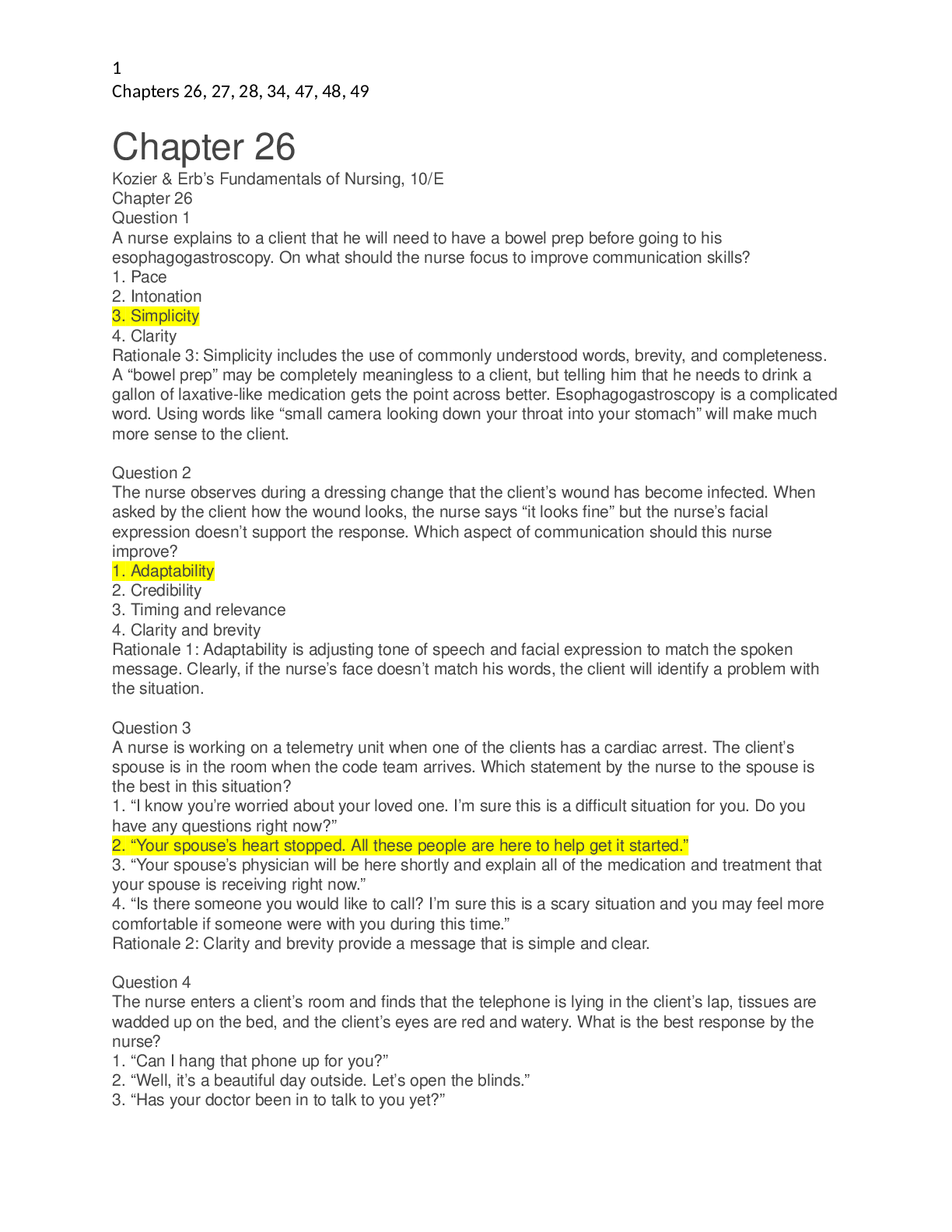
Buy this document to get the full access instantly
Instant Download Access after purchase
Add to cartInstant download
Reviews( 0 )
Document information
Connected school, study & course
About the document
Uploaded On
Sep 19, 2020
Number of pages
100
Written in
Additional information
This document has been written for:
Uploaded
Sep 19, 2020
Downloads
0
Views
207

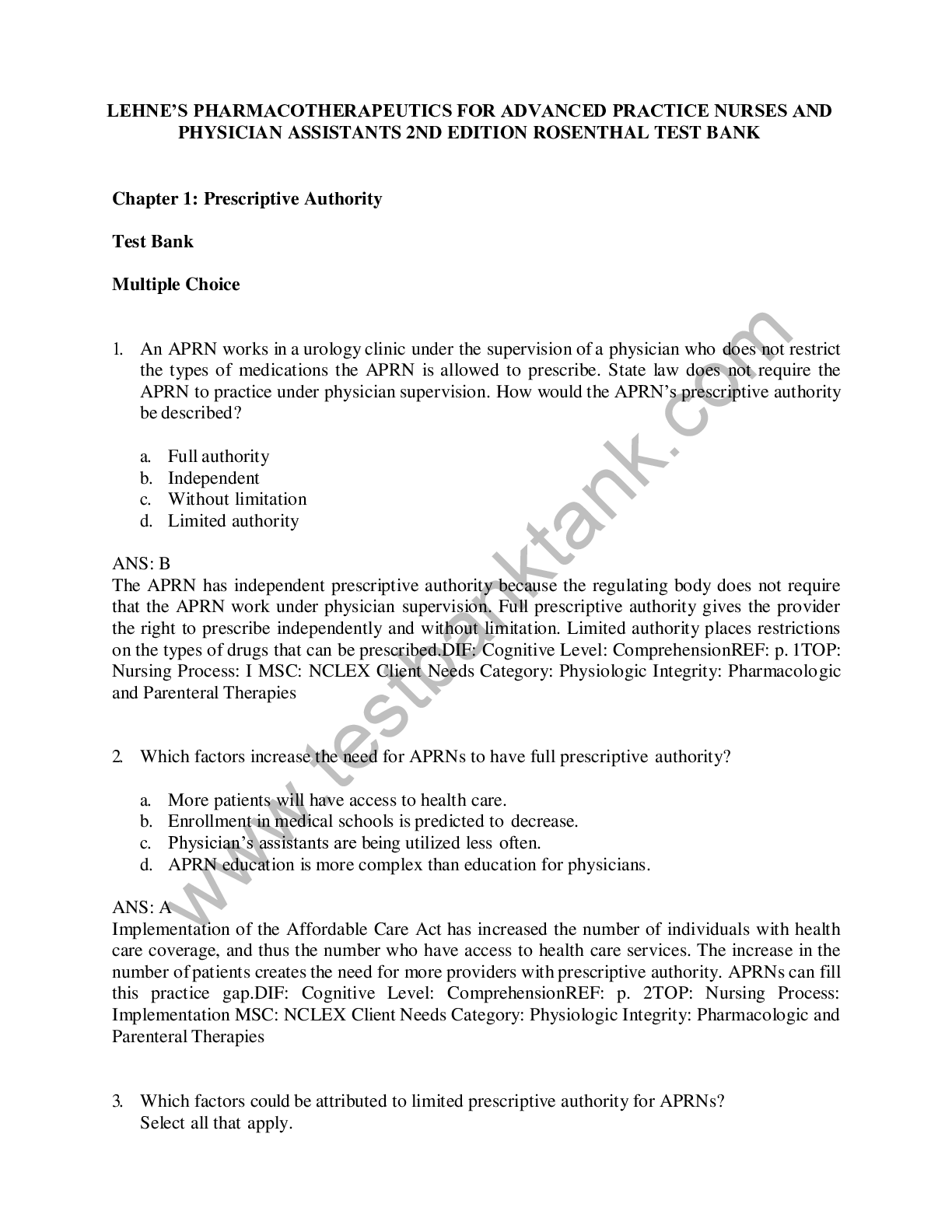


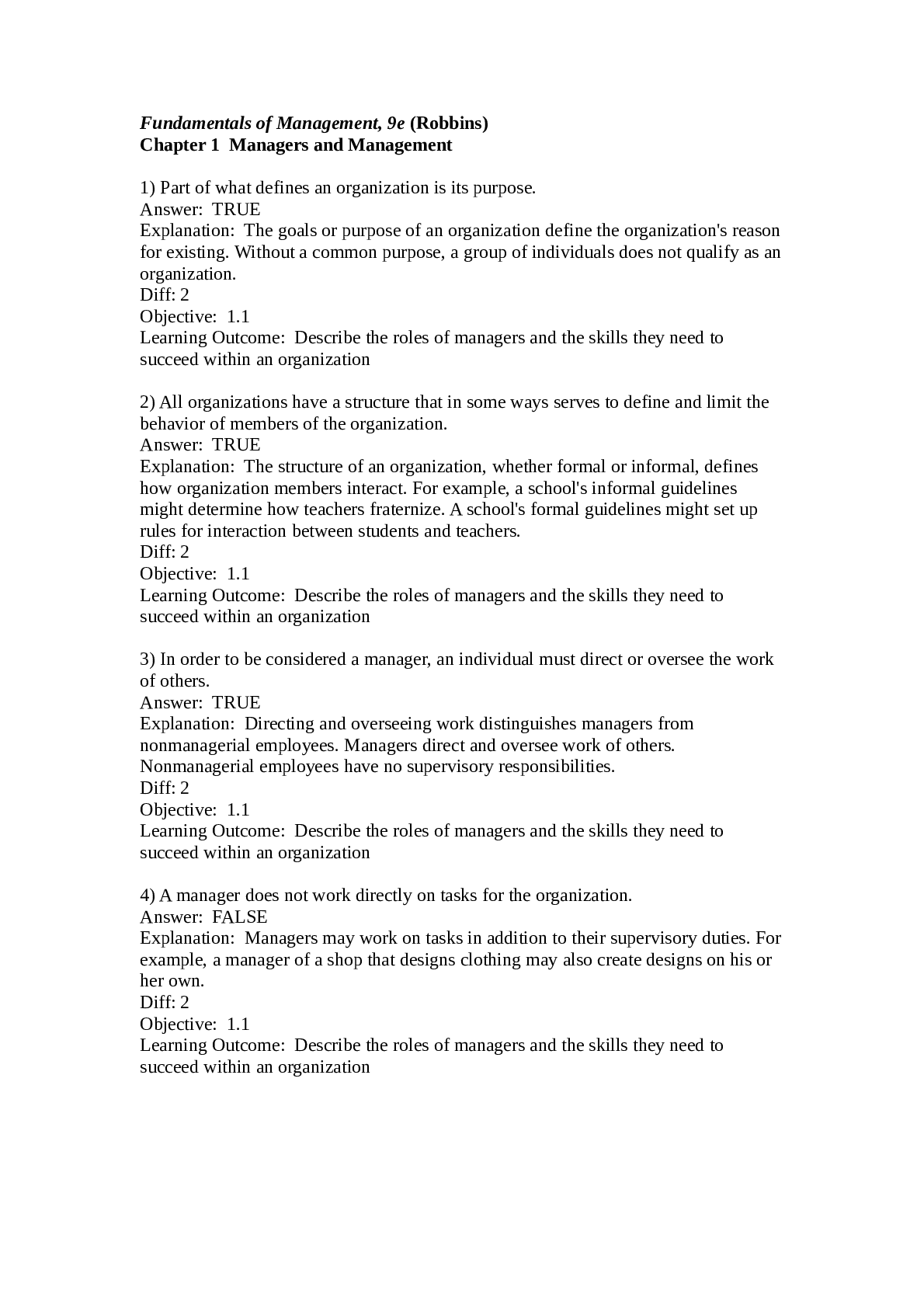
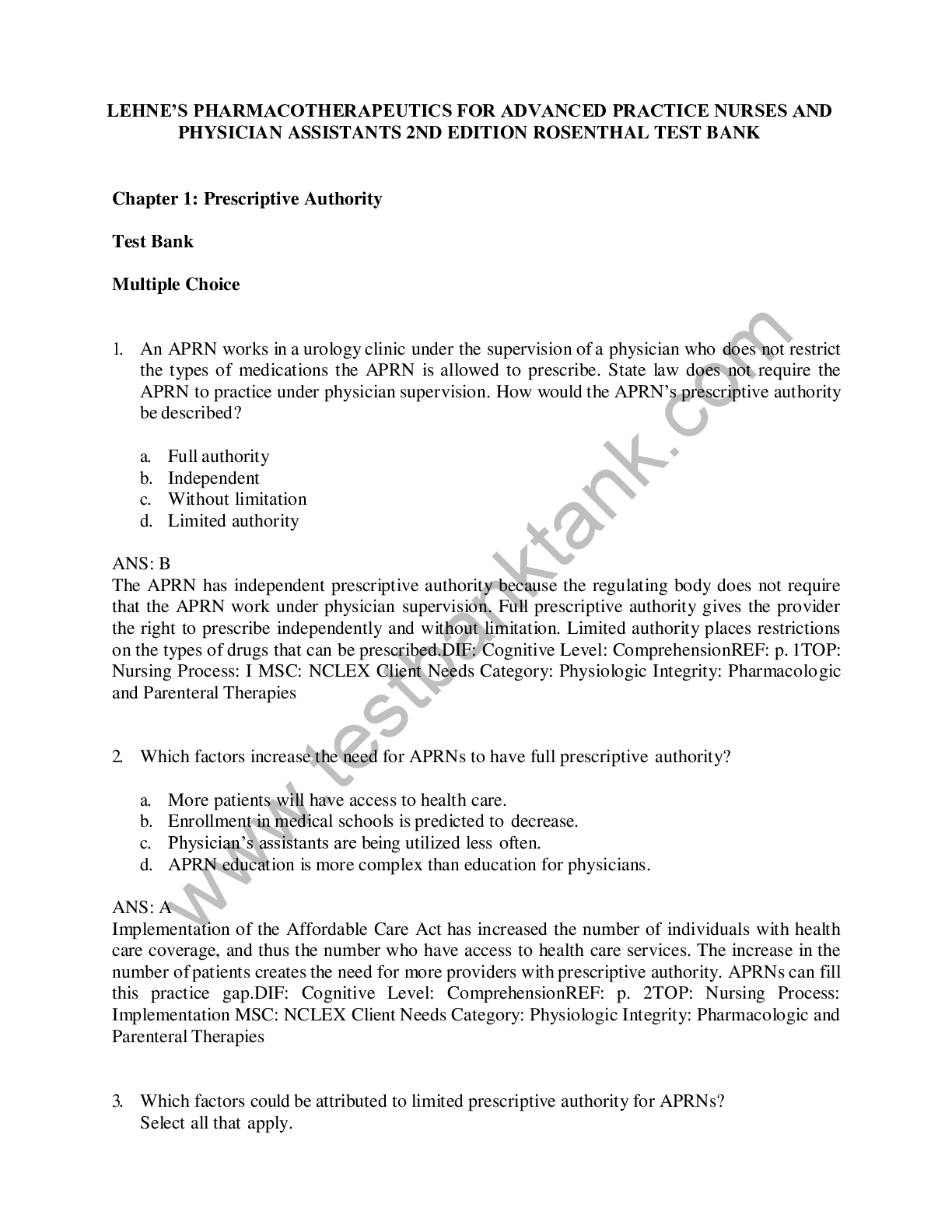
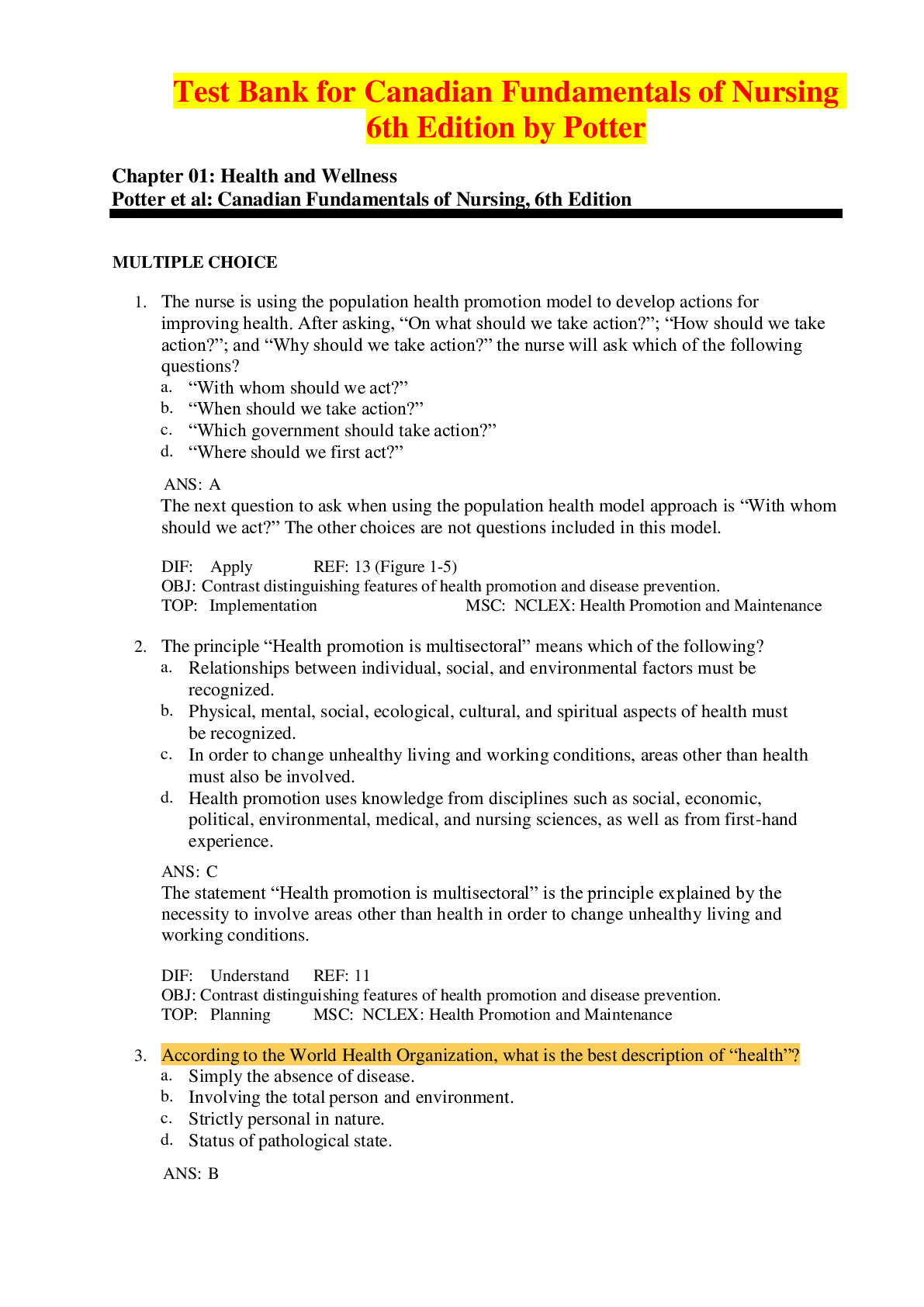
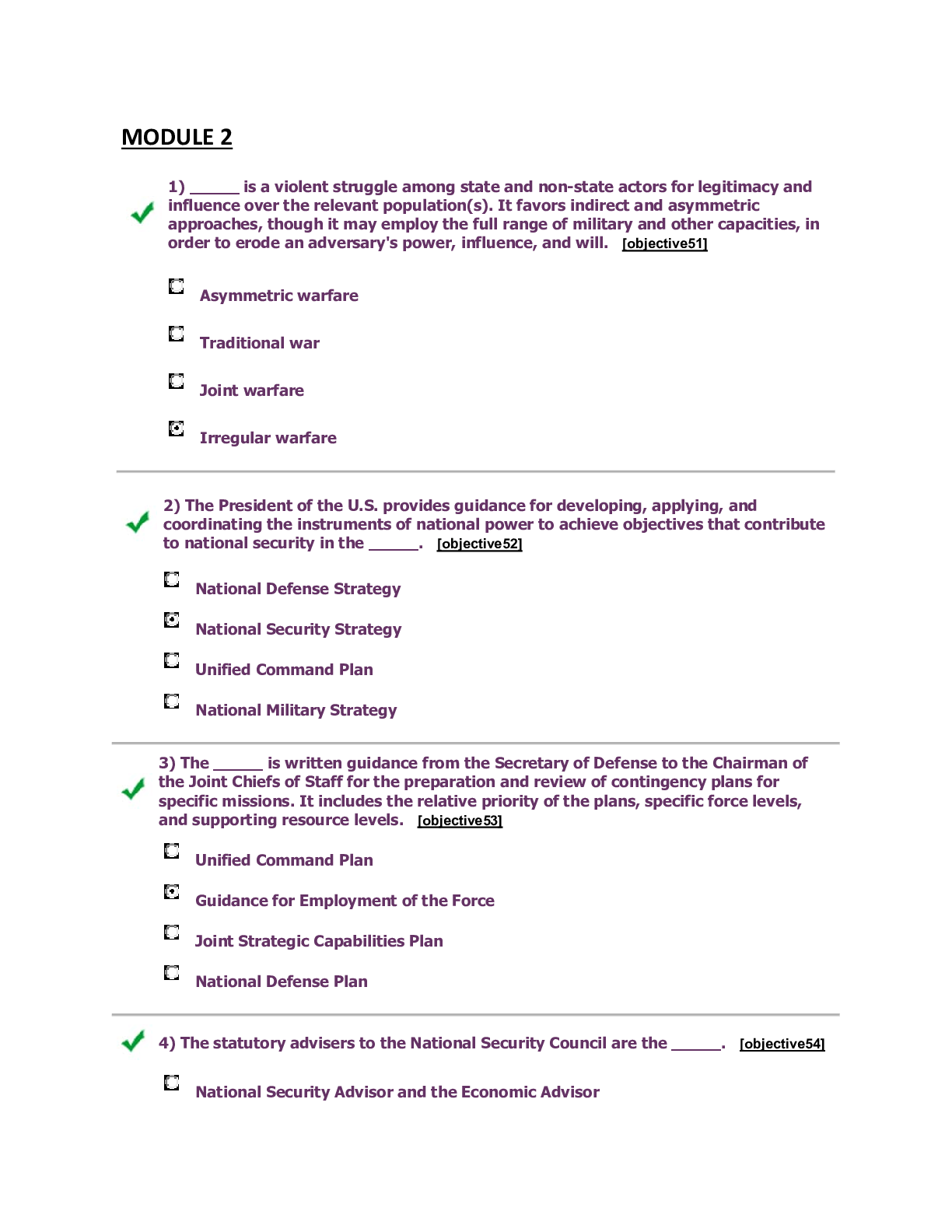
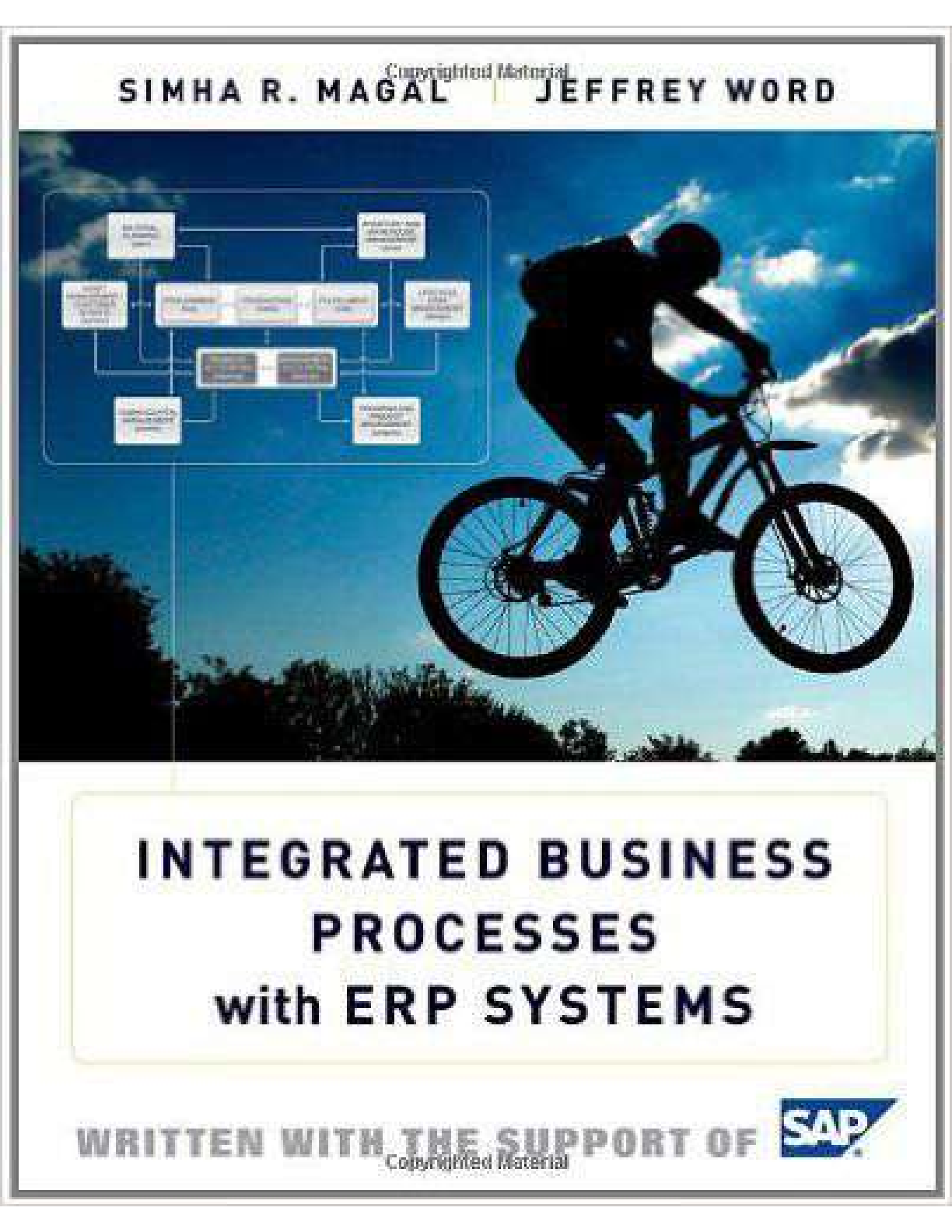

.png)
_compressed.png)
